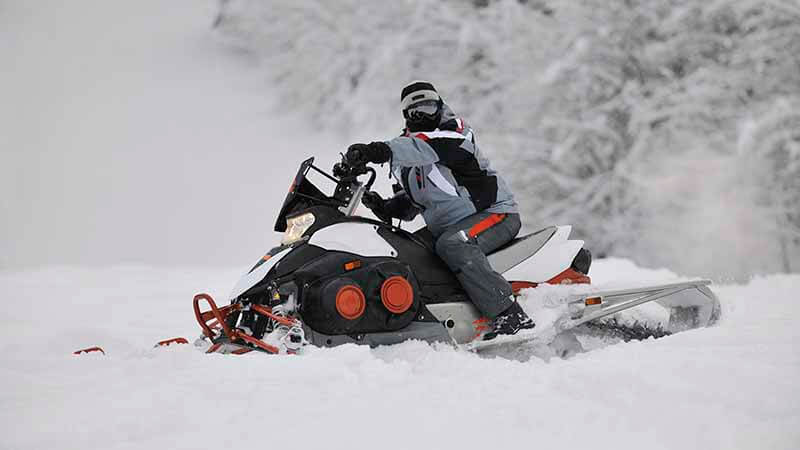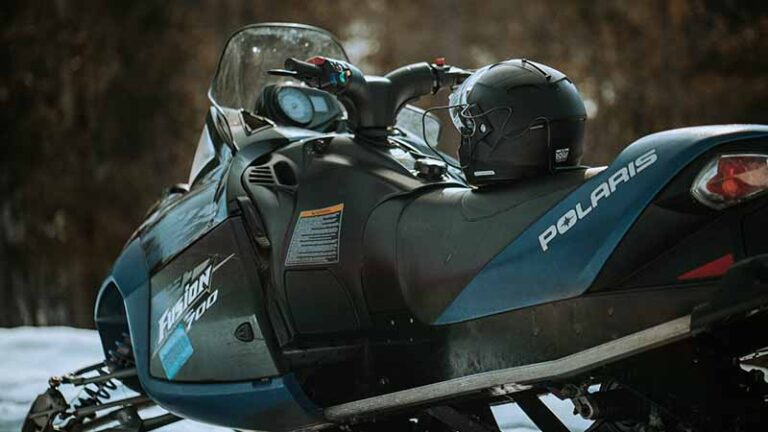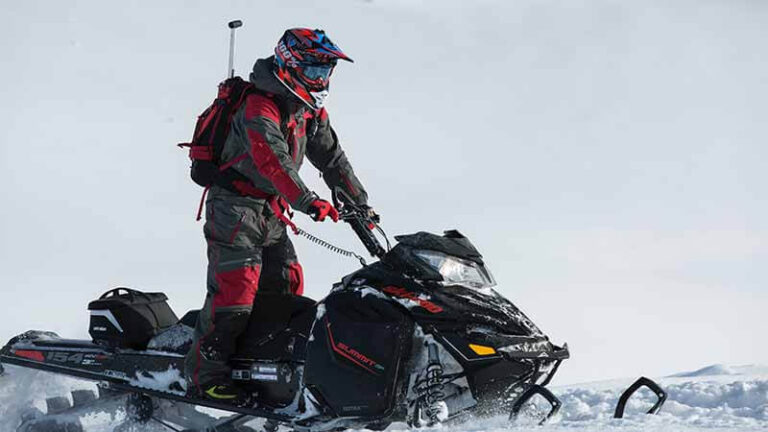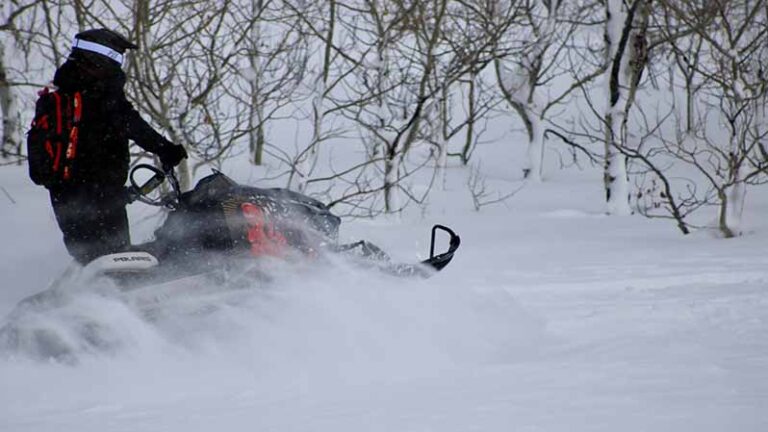Different Types of Snowmobile Covers: Pros and Cons
Your snowmobile is an important investment, and it must be protected to preserve its longevity and performance. Snowmobiles are built to resist a variety of weather conditions and terrains, but they are not indestructible. Exposure to severe conditions such as snow, rain, and UV radiation can cause wear and tear, paint fading, and potential damage to key components.
You may protect your snowmobile from environmental threats by using a snowmobile cover. The cover works as a protective barrier, keeping dust, debris, and moisture from gathering on the surface and sections of your snowmobile. It protects your car from snow buildup in areas with heavy snowfall, which can be very destructive if not removed promptly.
A snowmobile cover is also useful during the off-season or when the vehicle is not in use. Properly storing your snowmobile with a cover aids in the prevention of corrosion, rust, and other deterioration issues that might occur over time.
The role of snowmobile covers in preserving the vehicle
Snowmobile covers are essential for maintaining the overall condition and appearance of your vehicle. Here’s how they help to safeguard and extend the life of your snowmobile:
- Weather Elements Protection: Snowmobile covers are made from materials that provide varied degrees of water resistance and UV protection. They act as a shield against rain, snow, sleet, and damaging UV rays, preventing damage to the outside and interior components of your snowmobile.
- Dust & Debris Protection: Your snowmobile can accumulate dust, dirt, leaves, and other debris when in storage or when not in use. A cover protects your vehicle from harmful particles, keeping it clean and eliminating the need for frequent cleaning and maintenance.
- Preventing Fading and Oxidation: Prolonged sunshine exposure can cause your snowmobile’s paint to fade and the materials to deteriorate. A decent UV-protected snowmobile cover helps to prevent these damages, protecting the vehicle’s beauty and value.
- Snowmobiles are frequently exposed to moisture, which can lead to corrosion and rust on metal components. Using a waterproof cover protects your vehicle from moisture damage, increasing its lifespan.
- Security and privacy: A snowmobile cover not only protects your vehicle from the elements but also adds an extra degree of security by concealing it from prospective thieves or vandals.
The purpose of this blog post is to present a complete comparison of several types of snowmobile covers, concentrating on their unique benefits and drawbacks. It will help you make an informed decision when selecting the best cover for your snowmobiles.
Understanding Snowmobile Covers
Snowmobile covers are specially designed protective equipment that safeguard snowmobiles from numerous external elements and potential harm. These coverings are composed of tough materials, often nylon, polyester, or heavy-duty fabrics, and provide varied degrees of protection from elements like snow, rain, and UV rays.
The primary function of a snowmobile cover is to protect the vehicle during inactivity or storage. When snowmobiles are not in use, they are susceptible to dust, filth, and debris accumulation, which can ruin the vehicle’s appearance and lead to mechanical problems over time.
Furthermore, exposure to harsh weather factors such as rain and snow can harm delicate parts and components. A snowmobile cover works as a barrier, keeping these outside elements from hurting the vehicle and preserving its condition.
Factors to consider when choosing a snowmobile cover
- Material and durability: The material used for the cover has a considerable impact on its durability and efficacy in providing protection. Nylon coverings are lighter and less expensive in general, although polyester and heavy-duty covers provide higher durability and weather resistance.
- Size and fit: It is critical that the cover fits snugly over the snowmobile for maximum protection. It should cover the entire car without being too slack or tight, as this could cause tears or impair efficacy.
- Water resistance and weather protection: Consider your local climate and the level of protection required. Some coverings are specifically built for all-weather circumstances, with strong water resistance and snow protection, whereas others may simply provide basic rain protection.
- Installation and removal ease: The ease of installing and removing the cover should be considered. A cover with user-friendly features, such as elastic hems or tie-down straps, simplifies and speeds up the process.
- Storage and mobility: If you intend to travel regularly with your snowmobile, portability becomes critical. When not in use, look for covers that are lightweight, collapsible, and easy to store.
Consideration of these considerations when selecting a snowmobile cover will assist you in locating the best solution that matches your individual demands and provides excellent protection for your treasured machine.
Types of Snowmobile Covers
Standard Nylon Covers
Standard nylon covers are a popular and cost-effective way to protect your snowmobile. These covers have various benefits:
Pros
- Standard nylon coverings are affordable and generally available and may be obtained in a variety of stores and online merchants, making them accessible to a wide spectrum of snowmobile owners.
- Lightweight and easy to transport: Because these covers are lightweight, they are easy to carry and transport, making them ideal for travel and storage.
- Basic dust and debris protection: Standard nylon coverings successfully shield your snowmobile from dust, dirt, leaves, and other debris, keeping it clean during storage.
Cons
- Limited water resistance: While typical nylon coverings provide some water resistance, they are not completely waterproof, making them unsuitable for heavy rainfall or prolonged exposure to moisture.
- Extreme weather conditions may not be suitable: These coverings may not provide adequate protection for your snowmobile in areas with harsh weather, such as thick snow or strong winds.
Deluxe Polyester Covers
Deluxe polyester covers are superior to basic nylon covers in terms of features and protection:
Pros
- Polyester covers are more resilient and resistant to wear and tear than nylon covers, resulting in a longer lifespan.
- Better water resistance: These covers are more water resistant, protecting against mild to moderate rains.
- UV protection for the vehicle’s paint: Deluxe polyester coverings have UV-resistant characteristics that keep the sun’s rays from fading or damaging the paint of your snowmobile.
Cons
- Deluxe polyester covers may be slightly more expensive than normal nylon covers due to their superior quality and additional functionality.
- It is possible that they will not provide adequate protection from severe rain or snow: While they are more resistant to water, they may not be completely waterproof, limiting their effectiveness during severe rain or snowstorms.
All-Weather Heavy-Duty Covers
All-weather heavy-duty covers are built to withstand harsh weather and provide all-around protection:
Pros
Designed for extreme weather situations: These covers are specifically designed to endure extreme weather conditions such as heavy snow, rain, and direct sunlight.
High water resistance and snow protection: The heavy-duty materials are resistant to water and effectively prevent snow accumulation on your snowmobile.
UV protection and fade resistance: The UV-resistant characteristics of the cover preserve your vehicle’s paint and prevent fading even after extended exposure to sunshine.
Ventilation and secure straps: Some heavy-duty coverings include ventilation systems to avoid condensation buildup, while secure straps maintain a snug fit during severe winds.
Cons
More expensive than standard and deluxe covers: Because of their superior protection capabilities, all-weather heavy-duty covers are more expensive.
Heavier and bulkier to transport: Because of their sturdy structure, these covers can be heavier and bulkier to transport, making them less suitable for regular travelers.
Custom-Fit Covers
Custom-fit covers provide personalized protection that is particular to your snowmobile model:
Pros
- Specifically designed for your snowmobile model: Custom-fit covers are created to precisely suit your snowmobile’s dimensions and features, assuring a perfect fit with minimal looseness.
- Snug fit with minimal looseness: A snug fit improves protection by reducing gaps that could allow dust, debris, or moisture to access the vehicle’s surface.
- Enhanced weather protection: Because of their tailored design, these coverings provide excellent protection against numerous weather elements and potential harm.
Cons
- Custom-fit covers are often more expensive than universal-fit covers because of their personalized design.
- Snowmobile models that are older or less popular have limited availability: Finding custom-fit covers for uncommon or older snowmobile models may be more difficult than finding universal options.
Consider the distinctive characteristics and requirements of each type when selecting the correct snowmobile cover, and match them with your personal demands to provide the best protection and longevity for your snowmobile.
Choosing the Right Snowmobile Cover for Your Needs
Choosing the best snowmobile cover is a critical decision that is influenced by a variety of factors. Consider the following factors to make an informed decision:
Assessing your snowmobile storage conditions
Consider where and how you intend to store your snowmobile before choosing a cover. If you plan to leave it outside for an extended amount of time, you’ll need a cover that is both weather-resistant and UV resistant.
An all-weather high-duty cover may be the best alternative in areas with severe snowfall or rainfall. A regular or deluxe cover, on the other hand, may serve if you intend to store your snowmobile in a garage or enclosed place.
Determining your budget and priorities
Create a budget for snowmobile insurance based on your financial capabilities and priorities. Consider the expense of repairs or replacements if your snowmobile is not adequately safeguarded. While more modern covers with more features may cost more, they provide greater protection and longevity for your investment.
Considering the frequency of use and travel destinations
Consider how frequently you use your snowmobile and where you usually travel with it. A lightweight and portable cover may be desirable if you frequently take your snowmobile on lengthy travels or to different areas. A custom-fit or all-weather heavy-duty cover could give the essential protection for more intensive use and exposure to diverse conditions.
Reading user reviews and seeking expert recommendations
Look into user reviews and testimonials for the snowmobile covers you’re thinking about buying. Real-world feedback from other snowmobile owners can provide useful insight regarding the effectiveness, longevity, and overall quality of the coverings. Seek help from snowmobile enthusiasts or professionals in the industry who can provide valuable advice based on their knowledge and expertise.
You may make an informed selection and choose the snowmobile cover that best matches your demands and guarantees ideal protection for your important vehicle by carefully considering your snowmobile storage conditions, budget, usage habits, and expert suggestions. Remember that a good cover is vital for keeping the condition and worth of your snowmobile in the long run.
Maintenance and Care of Snowmobile Covers
Proper snowmobile cover maintenance and care are critical to ensuring its longevity and continuous usefulness in protecting your vehicle. Here are a few things to think about:
Cleaning and washing instructions
Cleaning your snowmobile cover on a regular basis helps to maintain its performance and aesthetics. Follow the cleaning instructions included with the cover, as different materials may require different care.
Most covers can be hand washed with mild soap and water, or machine washed on a moderate cycle if the material allows. Avoid using harsh chemicals like bleach, since these may damage the fabric or coatings of the cover. Allow the cover to air dry completely before storing it after washing.
Storing the cover properly when not in use
When not in use, store your snowmobile cover carefully to avoid damage and extend its longevity. Before folding the cover, make sure it is clean and totally dry. Avoid storing it in full sunlight or in places with excessive temperatures, since this might cause the material to degrade prematurely.
Use a storage bag or container to protect the cover from dust and other potential pollutants. Furthermore, if you reside in a rodent-infested area, take care to prevent rodents from breeding in the cover.
Repairing minor damages and tears
Inspect your snowmobile cover on a regular basis for signs of wear, tears, or damage. Minor damages, such as small tears or loose stitching, should be addressed immediately to prevent further degradation.
To mend small tears, utilize fabric repair kits or adhesive patches made expressly for the cover’s material. To identify the best course of action for more serious damages, consult the manufacturer or an expert.
Understanding warranty and return policies
When purchasing a snowmobile cover, become acquainted with the manufacturer’s or retailer’s warranty and return procedures. A solid warranty can give you peace of mind and ensure that you get help if the cover has any manufacturing flaws or is damaged prematurely. Make sure you understand the warranty period, what it covers, and any special limitations or criteria for claiming warranty services.
By following these maintenance and care procedures, you can extend the life and performance of your snowmobile cover, ensuring that it protects your vehicle effectively and remains in good shape for many years.
Remember that appropriate care not only benefits your snowmobile but also allows you to get the most out of your cover investment.
Conclusion
In conclusion, selecting the correct snowmobile cover is critical for assuring long-term protection for your prized possession. Throughout this blog post, we’ve looked at the numerous types of snowmobile covers on the market, each with its own set of benefits and cons.
A snowmobile is more than simply a vehicle of transportation; it symbolizes a love of adventure and a way to explore stunning winter landscapes. Investing in a decent snowmobile cover is an absolute must if you want to maintain your snowmobile in beautiful shape and running smoothly for years to come.
You may provide your snowmobile with the protection it needs by selecting a cover that is compatible with its storage conditions, budget, and usage patterns. Whether you store your snowmobile outside or indoors, travel regularly to different areas, or are subjected to extreme weather conditions, there is the right cover for you.
Remember that a snowmobile cover is more than an accessory; it is an investment in your snowmobile’s future. The appropriate cover protects your vehicle from dust, debris, moisture, and UV rays while also protecting its aesthetic and mechanical components. It protects your investment and saves you money on any repair bills.
As a result, we recommend all snowmobile fans to conduct a study and carefully select a snowmobile cover that provides the best protection for their prized vehicles. Don’t skimp on quality; go for long-lasting materials, high water resistance, and a secure fit that will last the test of time.







